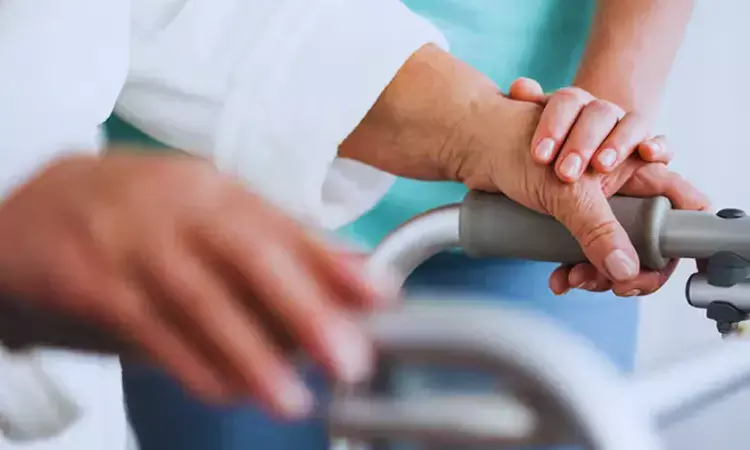- Home
- Medical news & Guidelines
- Anesthesiology
- Cardiology and CTVS
- Critical Care
- Dentistry
- Dermatology
- Diabetes and Endocrinology
- ENT
- Gastroenterology
- Medicine
- Nephrology
- Neurology
- Obstretics-Gynaecology
- Oncology
- Ophthalmology
- Orthopaedics
- Pediatrics-Neonatology
- Psychiatry
- Pulmonology
- Radiology
- Surgery
- Urology
- Laboratory Medicine
- Diet
- Nursing
- Paramedical
- Physiotherapy
- Health news
- Fact Check
- Bone Health Fact Check
- Brain Health Fact Check
- Cancer Related Fact Check
- Child Care Fact Check
- Dental and oral health fact check
- Diabetes and metabolic health fact check
- Diet and Nutrition Fact Check
- Eye and ENT Care Fact Check
- Fitness fact check
- Gut health fact check
- Heart health fact check
- Kidney health fact check
- Medical education fact check
- Men's health fact check
- Respiratory fact check
- Skin and hair care fact check
- Vaccine and Immunization fact check
- Women's health fact check
- AYUSH
- State News
- Andaman and Nicobar Islands
- Andhra Pradesh
- Arunachal Pradesh
- Assam
- Bihar
- Chandigarh
- Chattisgarh
- Dadra and Nagar Haveli
- Daman and Diu
- Delhi
- Goa
- Gujarat
- Haryana
- Himachal Pradesh
- Jammu & Kashmir
- Jharkhand
- Karnataka
- Kerala
- Ladakh
- Lakshadweep
- Madhya Pradesh
- Maharashtra
- Manipur
- Meghalaya
- Mizoram
- Nagaland
- Odisha
- Puducherry
- Punjab
- Rajasthan
- Sikkim
- Tamil Nadu
- Telangana
- Tripura
- Uttar Pradesh
- Uttrakhand
- West Bengal
- Medical Education
- Industry
Forearm DXA Scan: A Valuable Supplement for Osteoporosis Detection in Older Adults, Study Finds

Italy: A recent systematic review and meta-analysis explored the correlation between bone mineral density (BMD) measured at the forearm and at the lumbar spine or femoral neck, highlighting the potential role of distal forearm dual-energy X-ray absorptiometry (DXA) scans in osteoporosis assessment.
The findings were published online in BMC Musculoskeletal Disorders on February 14, 2025.
The researchers revealed that forearm BMD scans show a strong correlation with BMD measurements of the lumbar spine and femoral neck, highlighting their role as a valuable supplementary tool for osteoporosis detection. The meta-analysis of 5,941 participants reported pooled effect sizes of 0.603 for the lumbar spine and 0.641 for the femoral neck, reinforcing the clinical utility of forearm DXA, especially in older adults where lumbar or hip scans may not be feasible.
Osteoporosis is a major global health concern, contributing to increased fracture risk and reduced quality of life. While DXA scans of the lumbar spine and femoral neck are the gold standard for assessing bone mineral density, they are not always feasible in elderly patients due to degenerative changes, mobility issues, or the presence of surgical implants. Despite this, current osteoporosis guidelines do not consider forearm DXA a standard diagnostic tool, except in specific cases.
To address this gap, Chiara Ceolin, Geriatrics Division, Department of Medicine (DIMED), University of Padua, via Giustiniani 2, Padova, Italy, and colleagues conducted a systematic review and meta-analysis to evaluate the correlation between forearm BMD and BMD measurements at the lumbar spine and/or hip sites, assessing its potential as a supplementary diagnostic method.
For this purpose, the researchers registered the protocol in PROSPERO and adhered to PRISMA guidelines. They systematically searched major databases until August 2024 for studies assessing forearm DXA scans in detecting osteoporosis compared to central sites like the femoral neck and lumbar spine. A meta-analysis was conducted on studies reporting correlation coefficients between these measurements. Three reviewers independently assessed study quality using QUADAS-2 criteria, and a narrative synthesis was performed to summarize key findings across different patient groups.
Key Findings
- Thirteen studies published between 1992 and 2023 were included, involving 5,941 participants.
- Forearm DXA scans showed strong correlations with lumbar spine and femoral neck BMD, with pooled effect sizes of 0.603 (95% CI 0.579–0.627) and 0.641 (95% CI 0.600–0.680), respectively.
- Forearm BMD demonstrated good predictive value for central osteoporosis.
- Despite some variations in results, forearm DXA scanning proved to be a valid alternative, particularly in cases where lumbar or femoral assessments are difficult to perform.
The researchers demonstrated a strong correlation between forearm BMD and standard DXA measurements, highlighting the distal forearm as a valuable supplementary site for osteoporosis detection.
"Forearm DXA scans could aid in diagnosing osteoporosis, especially in older adults where lumbar or femoral assessments are unreliable. However, further research is needed to validate these findings across diverse patient groups," they concluded.
Reference:
Papa, M.V., Ceolin, C., Simonato, C. et al. The correlation between bone mineral density measured at the forearm and at the lumbar spine or femoral neck: a systematic review and meta-analysis. BMC Musculoskelet Disord 26, 151 (2025). https://doi.org/10.1186/s12891-025-08376-7
Dr Kamal Kant Kohli-MBBS, DTCD- a chest specialist with more than 30 years of practice and a flair for writing clinical articles, Dr Kamal Kant Kohli joined Medical Dialogues as a Chief Editor of Medical News. Besides writing articles, as an editor, he proofreads and verifies all the medical content published on Medical Dialogues including those coming from journals, studies,medical conferences,guidelines etc. Email: drkohli@medicaldialogues.in. Contact no. 011-43720751


